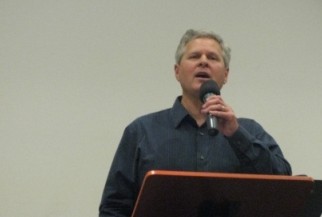
18 March 2013 by Tony Dibble-
The death of Christ includes understanding the following five simple theological concepts:
- substitution;
- propitiation;
- expiation;
- finality; and
- atonement.
A. CONCEPTS
First is:
Substitution which means Christ took our place to pay the price and penalty of sin, in order to set aside the claims of sin over our souls.
The next is;
Propitiation. This means sin, which has been committed, must be squared off/appeased/paid off: and that is what Christ did–He became sin for us so that GOD the Father’s law was complied with completely, without compromise. As GOD, He was perfect: as a man he took the place of mankind—the two natures in one. Perfect God as perfect man cleaned up the debt of sin that imperfect man could not.
Thirdly:
Expiation means that the penalty of our sins is fizzled out/expired: they expired with Christ’s death as He paid the price for our sins. He did not end sin but He ended its price and its power; unless we continue to let sin run alongside us.
Fourthly:
Finality refers to the finished work of Christ. This means that Christ has completed our salvation by His death, resurrection, ascension to, and intercession in Heaven: nothing more need be done to be saved from the claims of sin; “It is finished,” were Christ’s last words on the cross. He died once, and for all of us, as St. Paul tells us.
The fifth concept is:
Atonement means at “one-ment” with GOD: united with GOD because we are no longer under the law and power of sin as Christ defeated the claims and strength of sin on us. This is the one Anglo- Saxon concept in theology introduced by William Tyndale, the other concepts being either from Latin or Greek.
B. DIFFERENT VIEWS OF THE CELEBRATION OF THE LORD’S SUPPER
1. Catholic
The Roman Catholics maintain that the bread and wine are changed into the actual body and blood of Christ. This was first propounded by the Dominican monk Paschasius Radbertus in 831 A.D. It was developed further by Saint Thomas Acquinas for adoption by the Laterian Council in 1215 A.D. This view was drawn from the distinction between substance and form. This distinction between substance and form was made by the Greek philosopher Aristotle in the 4th century B.C. The early church was influenced by Greek concepts to an extent. The substance was Christ’s body and blood. The form was bread and wine. Transubstantiation is the term used to denote that the form is retained but the substance is changed.
Over time, the mystery associated with the the worship service resulted in the “priest” being given the power of transforming the bread and wine into the body and blood of Christ, thus re-enacting the sacrifice on Calvary. This then changed the basis of remembering the LORD’s Supper into one of re-enacting it. The host, from the Latin word “hostia” meaning sacrifice, was placed on the believer’s tongue and the wine was withheld from the congregation. If the wine was accidentally spilt, it would amount to sacrilege .Today, though the practice may vary, the original theology is retained by Roman Catholic Church.
2. Lutheran
To the Lutherans, there is no change in the substance of the bread and wine. To them, Christ is present “in, with, and under” the bread and wine. “Consubstantiation” is the term assigned. However, the Lutherans do not accept this term as they consider it misleading. This is because GOD is present in all things, though His presence is separate and not contaminated by the substance of things.
3. Presbyterian
To the Presbyterians (and the majority of the English speaking world is in this category) the issues of substance and presence do not matter. Calvin maintained instead, that the believer enters into a spiritual union with Christ in communion.
4. Real Presence
There are other views on the LORD’s Supper. An example is the doctrine of real presence. This is in fact one aspect of transubstantiation: it holds that the emblems are actually Christ’s body and blood.
5. Quaker
The Quakers hold that the sacraments were meant only for the apostolic age. They do not incorporate them in their worship service.
6. Zwinglian
Zwingli, a 16th century Swiss reformer a contemporary to Calvin, considered the LORD’s Supper a seal or pledge of what GOD does for the believer, although he at times appeared also to see it as a spiritual reminder of our union with Christ as Calvin did.
The different views on the celebration of the LORD’s Supper do not affect the theology of the LORD’s Supper. The reasons, effects and impact of the death of Christ are common to all sound Bible –believing Christians.
Note: Tony Dibble worships at Endeavour Christian Gathering in Mullaloo Perth, Australia for about 7 years. Prior to this, he was at Church of Our Holy Saviour, Labuan, East Malaysia. When he is in Kuala Lumpur, he now worships at Faith Oasis Fellowship Subang Jaya, Selangor.
Dear Viewers in Christ, if you find this article edifying to you, please share with your friends or loved ones by using the social media plugs (Share, Email to this article). The Lord will surely bless you as you bless others. May the Lord’s peace and love be with you. Amen.
Reference for pictures:
http://anunworthyservant.com/wp-content/uploads/2010/06/ChristOnCrossLoop.jpg
http://bereanbiblebaptistchurch.files.wordpress.com/2012/01/cross.jpg
http://www.truromethodist.org.uk/hp_wordpress/wp-content/uploads/2012/10/CommunionBreadWine.jpg
http://ptl2010.files.wordpress.com/2011/07/praise-you-god-i-give-it-all-to-you.jpg
http://b.vimeocdn.com/ts/291/998/29199805_640.jpg









Leave a Reply